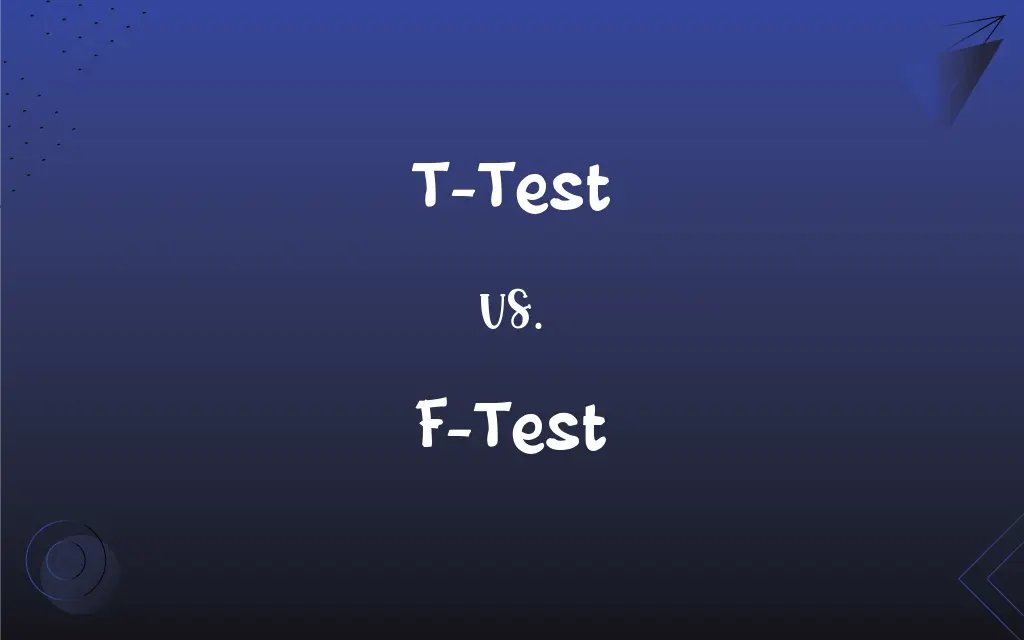T-Test vs. F-Test: What's the Difference?
Edited by Aimie Carlson || By Harlon Moss || Published on February 8, 2024
The T-test is used to compare the means of two groups, while the F-test compares variances between groups.

Key Differences
The T-test is a statistical test used to determine if there is a significant difference between the means of two groups, which is essential in comparing small sample sizes. In contrast, the F-test is used to compare the variances or dispersions between two or more groups, often used in the analysis of variance (ANOVA).
T-tests are versatile, allowing for one-sample, independent, or paired analyses, making them suitable for a range of scenarios, from medical to social science research. F-tests, however, are primarily used in the context of ANOVA to test the hypothesis that the means of several groups are equal, thus assessing variability among group means.
In T-tests, the data is assumed to follow a normal distribution, but they are robust to moderate violations of this assumption, especially in large samples. F-tests are more sensitive to non-normality and require a stronger adherence to the assumption of normality and homogeneity of variances.
T-tests are often used in situations where the sample size is small (typically less than 30), as they are specifically designed to tackle the variability that small samples entail. F-tests are more appropriate for larger, more complex experimental designs, especially when dealing with multiple groups and variables.
The outcome of a T-test is a T-value which, compared against a critical value from the T-distribution, can determine statistical significance. The F-test results in an F-value, which is then compared against critical values from the F-distribution to assess the variances between groups.
ADVERTISEMENT
Comparison Chart
Primary Use
Comparing means of two groups
Comparing variances between groups
Types
One-sample, independent, paired
ANOVA, comparing two variances
Assumptions
Normal distribution, especially for small samples
Normality, homogeneity of variances
Appropriate Sample Size
Typically small (<30)
Larger, more complex experimental designs
Statistical Outcome
T-value
F-value
ADVERTISEMENT
T-Test and F-Test Definitions
T-Test
A statistical test for comparing the means of two groups.
We used a T-test to compare the average scores of two classes.
F-Test
Suitable for complex experimental designs with multiple groups.
We used an F-test to analyze the data from our multi-faceted experiment.
T-Test
Assumes data is normally distributed.
Despite the normal distribution assumption, the T-test result was significant.
F-Test
Produces an F-value to assess variance significance.
The F-value indicated significant variance differences between the group means.
T-Test
Applicable for assessing differences in small sample sizes.
The T-test showed no significant difference in the treatment effects on the small patient group.
F-Test
Requires assumptions of normality and homogeneity of variances.
The F-test was valid as the data met the normality and homogeneity assumptions.
T-Test
Can be one-sample, independent, or paired.
A paired T-test was used to compare pre- and post-treatment results.
F-Test
Often used in analysis of variance (ANOVA).
The F-test in the ANOVA showed significant differences between the treatment groups.
T-Test
Results in a T-value for significance testing.
The T-value from the T-test was above the critical value, indicating a significant difference.
F-Test
A statistical test for comparing variances between groups.
An F-test was conducted to compare the variances in exam scores among four schools.
T-Test
(statistics) Student's t-test
FAQs
What is a T-test?
A T-test is a statistical method used to compare the means of two groups.
What is the primary purpose of an F-test?
The F-test's primary purpose is to compare variances between two or more groups.
Can a T-test handle large sample sizes?
While a T-test can handle larger samples, it is particularly useful for small sample sizes.
What are the assumptions for a T-test?
The T-test assumes normally distributed data.
What does a T-value indicate?
A T-value indicates the degree of difference between two group means.
What is an F-value?
An F-value is a statistical measure used in F-tests to assess variance significance.
When should a T-test be used?
A T-test should be used when comparing the means of two groups, especially with small sample sizes.
How do T-tests and F-tests differ in assumptions?
T-tests assume normal distribution, while F-tests require normality and homogeneity of variances.
What is an F-test?
An F-test is a statistical test used to compare variances between groups.
Is an F-test used for comparing means?
No, an F-test is used for comparing variances, not means.
What if data violates F-test assumptions?
Alternative non-parametric tests may be needed if F-test assumptions are violated.
Are F-tests and ANOVA related?
Yes, F-tests are commonly used in ANOVA to compare group variances.
Does an F-test determine specific group differences?
An F-test indicates if there is a variance difference, but not between specific groups.
Are T-tests and F-tests applicable in all fields of research?
Yes, both tests are widely used across various research fields.
What types of T-tests are there?
There are one-sample, independent, and paired T-tests.
How does sample size affect T-test validity?
Smaller sample sizes can make T-tests less reliable unless data is normally distributed.
Can a T-test be used for more than two groups?
No, T-tests are designed for two groups; for more, ANOVA with F-tests is appropriate.
What sample size is appropriate for an F-test?
F-tests are suitable for larger sample sizes and complex designs.
How is data normality important for T-tests and F-tests?
Normality ensures the validity of results in both T-tests and F-tests.
Can T-tests be used for paired samples?
Yes, paired T-tests compare means of related or matched samples.
About Author
Written by
Harlon MossHarlon is a seasoned quality moderator and accomplished content writer for Difference Wiki. An alumnus of the prestigious University of California, he earned his degree in Computer Science. Leveraging his academic background, Harlon brings a meticulous and informed perspective to his work, ensuring content accuracy and excellence.
Edited by
Aimie CarlsonAimie Carlson, holding a master's degree in English literature, is a fervent English language enthusiast. She lends her writing talents to Difference Wiki, a prominent website that specializes in comparisons, offering readers insightful analyses that both captivate and inform.







































































